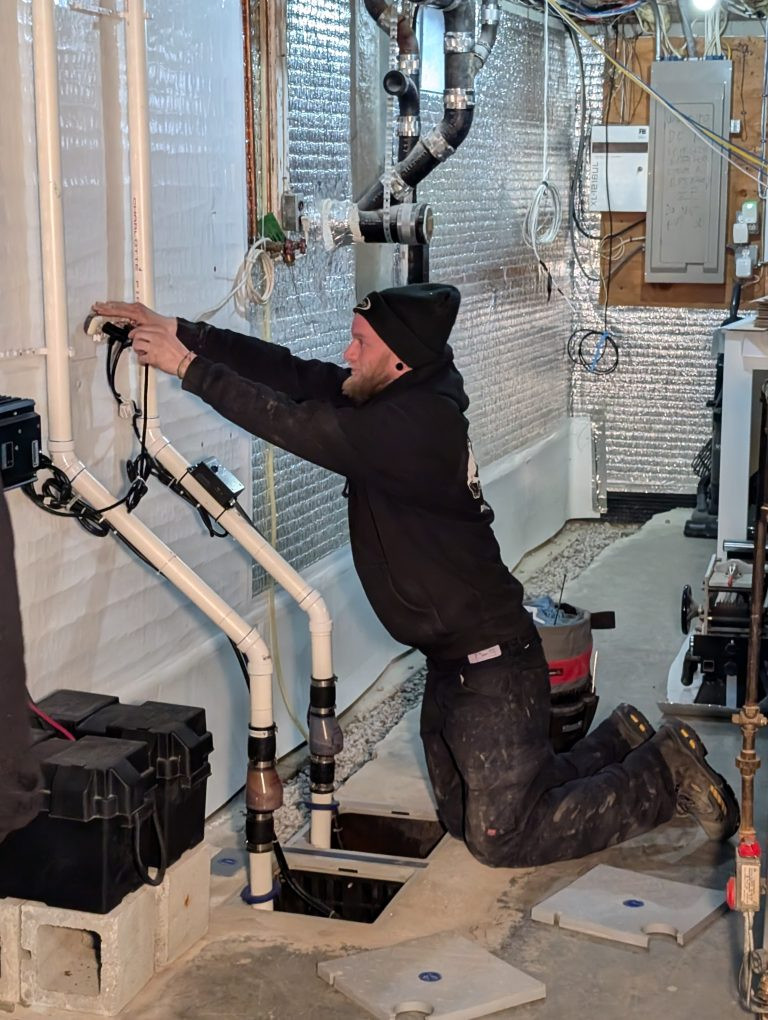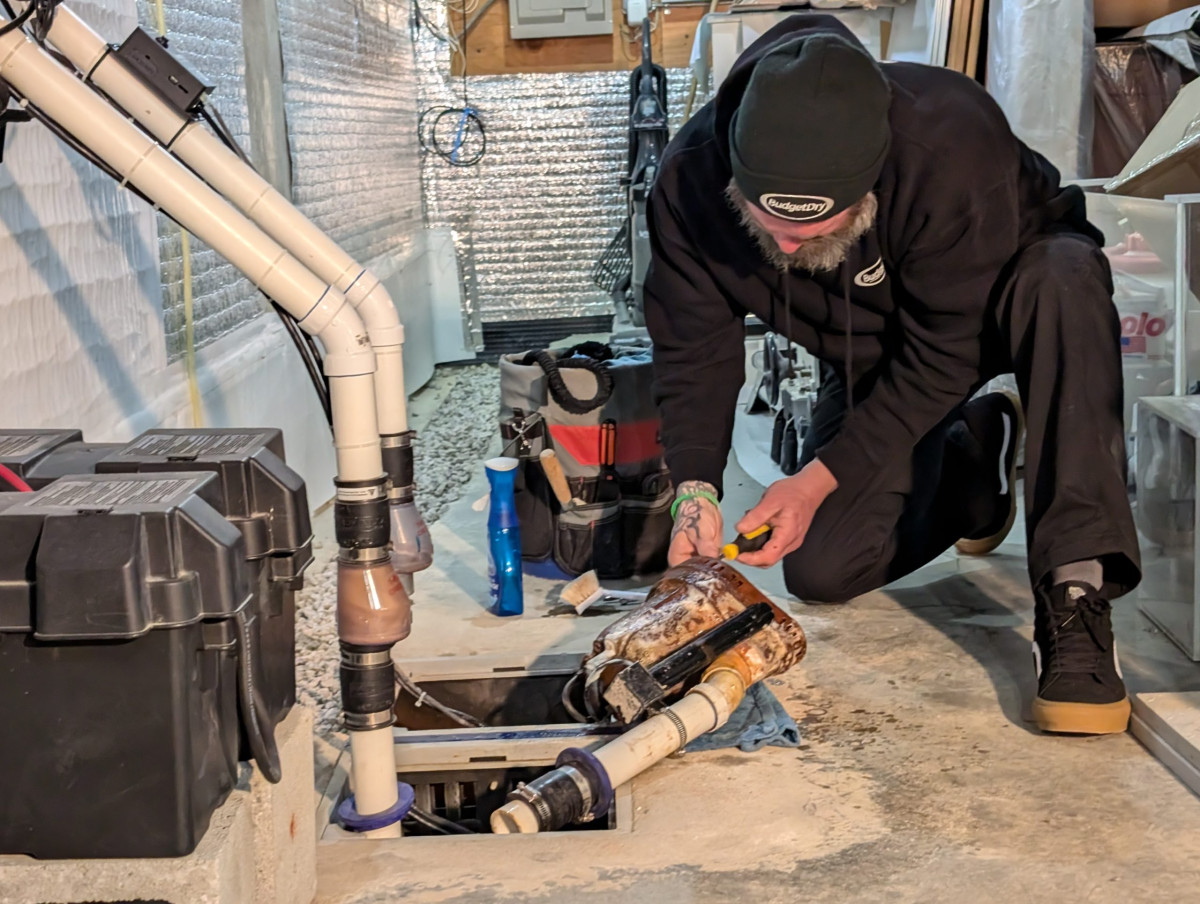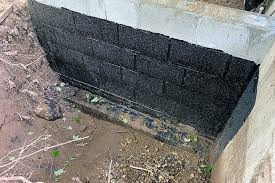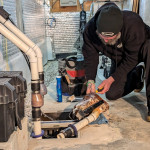Did you know that over 60% of U.S. homes suffer from below-ground wetness? As a homeowner, you’re faced with an essential decision when it comes to basement waterproofing – should you go for the interior or exterior approach? Each method has its pros and cons, and your choice can greatly impact not only your house’s value but also your peace of mind. So, what’ll it be? Stick around, and let’s weigh the options together.
Understanding Basement Waterproofing
Basement waterproofing, a vital aspect of home maintenance, might seem like a complex concept at first glance. However, you’ll find it’s quite straightforward once you understand its primary aims: to prevent water intrusion, maintain structural integrity, and guarantee a dry, usable space in your home.
Waterproofing encompasses various methods and materials used to prevent water from penetrating a building’s basement. Water can make its way into a building in numerous ways, but the most common is through your basement walls and floors. Therefore, it’s essential to confirm that your basement is adequately waterproofed.
Exterior waterproofing involves strategies that stop water at its source, keeping it from ever reaching your basement walls. This method is typically more invasive and costly but can offer the most thorough protection against moisture.
On the other hand, interior waterproofing, which we’ll explore in the next section, primarily manages water that has already entered your home.
Understanding these basic principles of basement waterproofing is the first step in determining the best approach for your home. It’s an important investment that protects the longevity and value of your property.
The Basics of Interior Waterproofing
Let’s move on to understand the basics of interior basement waterproofing.
This process is essential for preventing water intrusion into your basement, thereby maintaining the structural integrity of your home.
You’ll find that interior waterproofing offers various benefits, including mold prevention, increased property value, and enhanced living conditions.
Understanding Interior Waterproofing
When it comes to protecting your home from water damage, understanding the basics of interior waterproofing is vital. This process is designed to manage water that’s already found its way into your home, unlike exterior waterproofing which aims to prevent water intrusion in the first place.
Interior waterproofing typically involves the use of sealants and coatings on your walls and floors to prevent moisture from seeping in. The application process is fairly straightforward and it’s usually more affordable than exterior waterproofing methods.
But it’s essential to recognize that while these sealants and coatings can effectively keep out moisture, they don’t solve the underlying issue of water accumulation around your foundation.
Another key aspect of interior waterproofing is installing a sump pump. This device collects water from around your foundation and pumps it away from your home. You might also need drain tiles or French drains to channel water to the sump pump.
While interior waterproofing can be an effective solution for managing moisture, it’s often used in conjunction with exterior methods for maximum protection.
It’s a vital part of a thorough approach to basement waterproofing, so don’t overlook its significance.
Interior Waterproofing Benefits
Building on the basic understanding of interior waterproofing, it’s time to highlight the benefits this method brings to your home. One key advantage is its cost-effectiveness. Interior waterproofing typically requires less labor and materials than exterior methods, saving you money.
Another significant benefit is the minimal disruption it causes. As interior waterproofing focuses on the inside of your home, there’s no need for excavation or major landscaping work. This reduces the physical changes to your property and limits any disturbance to your daily routine.
Interior waterproofing also offers more flexibility. It can be carried out in stages, allowing you to spread the cost and disruption over time. You can also choose from a range of techniques, including sealants, drainages, and sump pumps, to best suit your needs and budget.
Pros of Interior Waterproofing
Delving into the pros of interior basement waterproofing, you’ll find numerous benefits that are worth considering.
For starters, it’s often less costly than exterior waterproofing. This makes it a more budget-friendly option, especially if you’re dealing with financial constraints.
Interior waterproofing can also be less disruptive to your property. Unlike exterior solutions that require significant digging, this method typically involves working within your home’s existing structure. You won’t have to worry about landscaping disruptions or potential damage to your property’s exterior.
Another key benefit is that interior waterproofing can be done all year round. It’s not weather-dependent like exterior waterproofing, which can be hindered by rain, snow, or freezing temperatures. This means you can address water issues promptly, minimizing potential damage to your property.
Lastly, interior waterproofing effectively manages water that has already made its way inside, directing it away from your basement. It’s a practical solution for homes in areas prone to high groundwater levels or frequent heavy rains.
Cons of Interior Waterproofing
While interior waterproofing has its merits, it’s vital to evaluate some potential drawbacks. One significant disadvantage is that it doesn’t address the source of water intrusion. When you’re dealing with interior waterproofing, you’re fundamentally managing the water that’s already made its way inside. It doesn’t prevent water from entering; it simply directs it elsewhere.
Another issue is the potential for damage to your home’s structure. Since interior waterproofing involves installing a drainage system under the floor, it can be quite invasive. Your floor and walls may need to be excavated to install the system, causing potential damage and a fair amount of mess.
Lastly, interior waterproofing can be expensive. The cost of materials and labor, combined with potential repair work resulting from the invasive installation process, can add up quickly. Not to mention, if the waterproofing fails, you’ll be facing even more costs to fix it.
Exterior Waterproofing Explained
Having considered the advantages and drawbacks of interior waterproofing, it’s time we turn our attention to another viable solution—exterior waterproofing.
Unlike interior methods, exterior waterproofing aims to prevent water from ever reaching your basement walls. It’s fundamentally a proactive approach, tackling the problem at its source.
You’ll find that exterior waterproofing typically involves a few key steps. First, the ground around your home needs to be excavated to expose the foundation walls.
Once exposed, a waterproof material or membrane is applied to the walls. This creates a barrier that can effectively repel water, preventing it from seeping through the wall into your basement.
Another vital element of exterior waterproofing is the installation of a drainage system. This system is designed to divert water away from your foundation, further safeguarding your basement against potential water damage.
It’s important to note that this method requires more labor and can be more expensive upfront than interior methods.
However, if done properly, exterior waterproofing can offer a more permanent solution, sparing you from future water-related headaches.
Now, let’s explore the benefits of this approach.
Benefits of Exterior Waterproofing
Exterior waterproofing provides two key benefits you’ll want to contemplate: it helps prevent structural damage and can enhance your home’s value.
By keeping moisture out, you’re safeguarding the integrity of your home’s foundation.
Plus, a well-maintained, waterproofed basement is a strong selling point, potentially boosting your property’s market worth.
Preventing Structural Damage
A significant advantage of exterior basement waterproofing is its ability to prevent structural damage. Your home’s foundation is what everything else rests on, and any weakness or instability can lead to major problems. When water seeps into your basement, it can undermine the structural integrity of your home.
Exterior waterproofing acts as a barrier, preventing water from making its way into your foundation. It’s like an umbrella for your home, keeping the damaging effects of water at bay. This method involves applying a waterproof membrane to the outside of your basement walls, and can also include installing a drainage system to redirect water away from your home.
When water can’t penetrate your foundation, you’re less likely to deal with issues like cracks, leaks, and the potential for collapse. You’re also preventing the growth of mold and mildew, which can be damaging to both your home and your health.
Additionally, by stopping water before it gets in, you’re reducing the risk of damage to your interior walls, flooring, and possessions.
In essence, exterior waterproofing is a preventative measure. It’s an investment in the longevity of your home and your peace of mind. It’s not just about keeping your basement dry, it’s about keeping your home safe and sound.
Enhancing Home Value
Investing in exterior basement waterproofing can greatly enhance your home’s value.
It’s not just about avoiding damage and maintaining your home’s structural integrity. It’s also about potential financial gain.
When potential buyers are evaluating homes, they’ll look at the basement closely. If they notice signs of past or potential water damage, they may lower their offer or even choose another home altogether.
However, if you’ve invested in exterior waterproofing, you can proudly show off a dry, well-maintained basement that’s ready for use. This can greatly increase the value of your home.
Moreover, exterior waterproofing can save you money in the long term.
It’s a proactive measure that can prevent costly repairs down the line. If you’ve ever had to deal with water damage, you know how expensive it can be.
Downsides of Exterior Waterproofing
Despite its many benefits, the path of exterior basement waterproofing isn’t always sunshine and rainbows. One major downside is the invasive nature of this method. It requires excavation around your home’s perimeter, which can be disruptive and damaging to landscaping.
You’ll need to brace yourself for a messy yard and potential damage to plants or patios.
In addition, there’s the issue of accessibility. If your house is closely situated to others or has limited outdoor space, exterior waterproofing mightn’t be a feasible option.
It also becomes challenging when dealing with structures like porches, driveways, and decks that obstruct the foundation.
Another drawback is the fact that exterior waterproofing doesn’t address water issues originating from inside the basement, such as condensation or plumbing leaks.
Since it focuses on preventing water from entering the basement from the outside, it mightn’t solve all of your water problems.
Lastly, exterior waterproofing isn’t a DIY-friendly task. It requires professional expertise and specialized equipment, which means you can’t tackle it as a weekend project.
It’s not something you can take lightly, as improper installation can lead to more problems down the line.
Cost Comparison: Interior vs. Exterior
When it comes to basement waterproofing, your pocketbook might feel a pinch.
Whether you choose interior or exterior methods, both come with significant costs. However, the cost differences between the two are notable, and it’s crucial to understand them.
Exterior waterproofing is often more expensive, with costs ranging from $15,000 to $30,000 for an average-sized home.

It’s a thorough solution, providing prevention from both minor leaks and severe water damage. It involves excavating the soil around your home, installing a waterproof membrane on the outside walls, and placing a drainage system.
The high cost is due to the labor-intensive nature of the process and the materials used.
On the other hand, interior waterproofing is usually cheaper, with costs ranging from $600 to $3,000.
It’s a simpler process, often involving the application of sealants to your walls and floor, and perhaps installing an interior drainage system.
However, it’s more of a damage control solution than a preventative one, as it deals with water after it’s entered your basement.
Making the Right Waterproofing Decision
Steering the decision between interior and exterior basement waterproofing can be tricky. It’s not just about cost. You also need to contemplate factors like your property’s unique features, the severity of your water problem, and potential future issues.
First, you’ll want to understand the specifics of your situation. Is your basement damp or is water actively seeping in? Dampness could be solved with interior methods, while seepage might need a more robust exterior solution.
Next, think about your home’s structure. If you have a finished basement or landscaping near your home, exterior waterproofing could be disruptive and costly. On the other hand, if your foundation is severely damaged, interior methods won’t be enough.
Lastly, weigh long-term factors. If you plan to sell your home, for example, exterior waterproofing could be a selling point. But if you’re staying put and your water issue is minor, an interior solution might suffice.
So, you’re stuck between a rock and a hard place, huh? Interior or exterior basement waterproofing? Sure, interior’s easier on the wallet and less messy, but it’s like slapping a Band-Aid on a bullet wound. Exterior’s pricier and dirtier, but it’s the Superman of solutions. It’s your fortress against future water woes. Bottom line? Dig deep into your budget and water issues before deciding. After all, your home’s health is not a game of chance.




